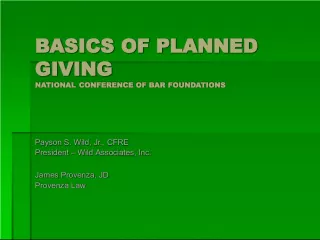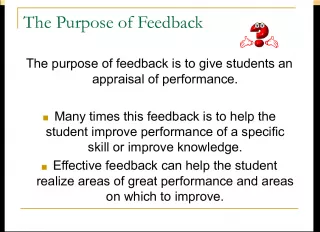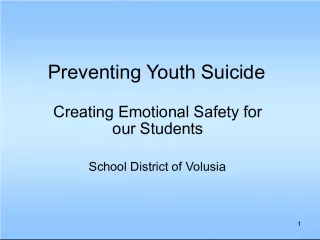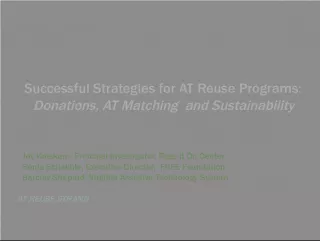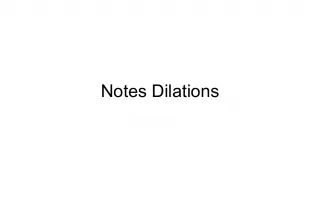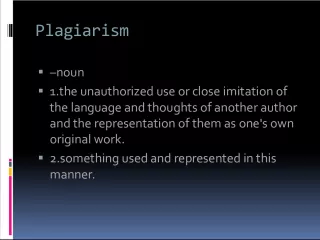Key Factors for Successful Giving and Receiving Feedback
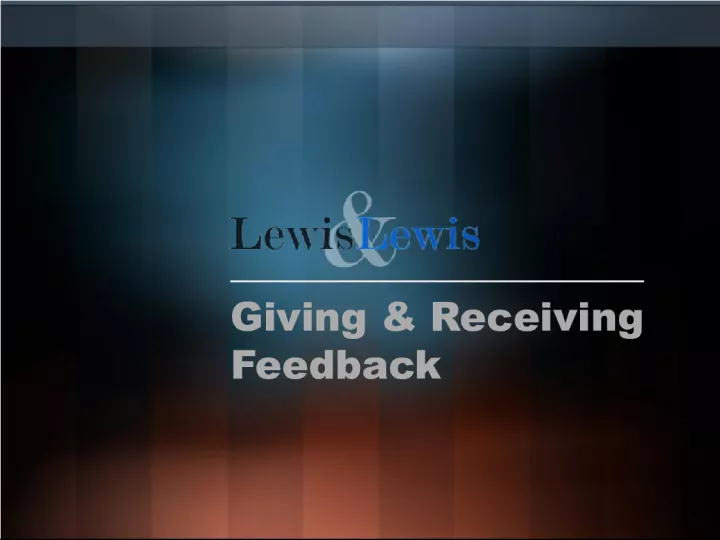

Psychologists Rebecca Carmichael and Lee Oliver explain that people develop skills by learning relevant concepts, receiving good quality feedback, reflecting constructively on feedback, and deciding to make changes. However, individuals may be inhibited from learning from feedback if they feel unsafe, need to defend themselves, or are unable to apply feedback to improve their performance.
- Uploaded on | 86 Views
-
 wiltonberge
wiltonberge
About Key Factors for Successful Giving and Receiving Feedback
PowerPoint presentation about 'Key Factors for Successful Giving and Receiving Feedback'. This presentation describes the topic on Psychologists Rebecca Carmichael and Lee Oliver explain that people develop skills by learning relevant concepts, receiving good quality feedback, reflecting constructively on feedback, and deciding to make changes. However, individuals may be inhibited from learning from feedback if they feel unsafe, need to defend themselves, or are unable to apply feedback to improve their performance.. The key topics included in this slideshow are Giving Feedback, Receiving Feedback, Learning, Constructive Reflection, Performance Improvement,. Download this presentation absolutely free.
Presentation Transcript
1. Giving & Receiving Feedback
2. Rebecca Carmichael - Psychologist Lee Oliver - Psychologist
3. People develop skills through: learning relevant concepts getting good quality feedback on performance reflecting constructively on feedback deciding to do something different in future to improve performance
4. People will be inhibited from learning from feedback if they: feel unsafe feel the need to defend themselves are unable to see how to apply the feedback to improve performance
5. Two dimensions to feedback Challenge Support
6. Two dimensions to feedback High Challenge High Support Low Challenge Low Support
7. Two dimensions to feedback High Challenge High Support Low Challenge Low Support Good, carry on, seems to be working
8. Two dimensions to feedback High Challenge High Support Low Challenge Low Support In passing Nothing Unspecific Dismissive
9. Two dimensions to feedback High Challenge High Support Low Challenge Low Support That was great, youre obviously trying very hard
10. Two dimensions to feedback High Challenge High Support Low Challenge Low Support Patronising General Safe
11. Two dimensions to feedback High Challenge High Support Low Challenge Low Support Well that could have been done better why did you not focus more early on?
12. Two dimensions to feedback High Challenge High Support Low Challenge Low Support Critical Induces defensiveness Paralysing
13. Two dimensions to feedback High Challenge High Support Low Challenge Low Support A good effort, I could see how you were drawing the feelings out I wonder if you got to the crux of the matter?
14. Two dimensions to feedback High Challenge High Support Low Challenge Low Support Focused Attentive Threatening?
15. Good Effective Feedback High Challenge High Support Low Challenge Low Support High Challenge High Support
16. Good Effective Feedback High Challenge High Support Is descriptive NOT evaluative or judgemental The class became rowdy because you moved too quickly between activities
17. Good Effective Feedback High Challenge High Support Is descriptive NOT evaluative or judgemental The way you moved quickly between activities seemed to unsettle the class
18. Good Effective Feedback High Challenge High Support Is specific rather than general The example you used to teach algebra was very practical.
19. Good Effective Feedback High Challenge High Support Takes into account the needs of the giver and the receiver Location Privacy Personality Mood
20. Good Effective Feedback High Challenge High Support Is directed towards behaviour the receiver can do something about
21. Good Effective Feedback High Challenge High Support Is solicited and welcomed not imposed
22. Good Effective Feedback High Challenge High Support Is well timed
23. Good Effective Feedback High Challenge High Support Includes checks to ensure clarity and understanding
24. Good Effective Feedback High Challenge High Support Feedback should refer to relevant performance, behaviour or outcomes, not the individual as a person. Distinguish the behaviour from the person
25. Good Effective Feedback High Challenge High Support Feedback should avoid emotion-raising, loaded terms (this generates defensiveness)
26. Receiving Feedback with Skill Practice reflective listening Do not get defensive - make a mental note of disagreements Paraphrase what you hear to check your perception and your assumptions Ask questions for clarification and for examples where you are unsure
27. Receiving Feedback with Skill Show appreciation (thank you) and respect for the person who has been kind enough to offer feedback Carefully evaluate the accuracy and potential value of what you have heard
28. Receiving Feedback with Skill Gather additional objective information from other peoples reactions Do not overreact to feedback, but modify your behaviours as suggested and watch the results
29. Exercise
30. Ten Tips for Giving Feedback 1. Present perceptions, reactions and opinions as such, not as facts. 2. Feedback should refer to relevant performance, behaviour or outcomes, not to the individual as a person. Distinguish the behaviour from the person. 3. Feedback should be in terms of specific, observable behaviour (not general or global) 4. When feedback must be evaluative rather than descriptive, it should be in terms of established criteria.
31. Ten Tips for Giving Feedback 5. Feedback about performance should provide examples of what are high and low areas of that performance, as well as specific behaviours, which appear to be contributing ot or limiting effectiveness. 6. In discussing problem areas where there are established procedures or solutions, suggestions should be given on means to improve performance. 7. Feedback should avoid emotion-raising, loaded terms (this generates defensiveness)
32. Ten Tips for Giving Feedback 8. Feedback should deal with things, which the individual can control. 9. When encountering emotional reactions or defences, these should be dealt with as such, rather than arguing or trying to convince by logic of facts. 10. Feedback should be given in a way to show acceptance of the receiver as a worthwhile person and as someone who has the right to be different.
33. The Yes and Principle The Art of BUT Listening The word BUT acts to negate whatever it follows, so when used in reply to an idea, as yes, but it relays a message that we disagree with the idea, and the word yes is meaningless. Compare these two phrases: Thanks for your idea, but let me tell you about Thanks for your idea, and let me tell you about..
34. The Yes and Principle BUT disconnects, demolishes and creates spikes. AND connects, builds and creates flow. Fundamentally it is about your ability to acknowledge the validity of an expressed opinion.
35. Pendletons Rules (Pendleton D, Schofield T, Tate P, Havelock P. The New Consultation. Oxford University, 2004.) A Model for Giving and Receiving Feedback The learner goes first and performs the activity Questions then allowed only on points of clarification of fact The learner then says what they thought was done well The teacher then says what they thought was done well The learner then says what was not done so well, and could be improved upon The teacher then says what was not done so well and suggests ways for improvements, with discussion in a helpful and constructive manner
36. Three Stage Model for Giving & Receiving Feedback Whats gone well? If you start with something positive you gain their interest they are less likely to be defensive What could be improved? Look forward not back. Concentrate on what there is to learn from the situation, how to avoid unwanted situations arising again. Should haves induce feelings of guilt and sap energy, and inhibit learning from feedback. What specifically could we do differently in future? Produce an action plan, identify next steps. Agree in detail who will do what differently in future.
37. Observation versus deduction Separate behaviour and interpretation Make interpretations tentative I noticed at this stage that you moved more in your seat, and your face became red, I wondered if you might be embarrassed? I saw you look at your watch and thought you might be bored I saw him talking with his hand over his mouth and wondered if he was lying
38. Phrases that show acceptance: I like the way you handled that. I like the way you tackle a problem. I am glad you are pleased with it. Since you are not satisfied, what do you think you can do so that you will be pleased? It looks as if you enjoyed that. How do you feel about it?
39. Phrases that show confidence: Because of what I know about you, I am sure you will do fine. Youll make it! I have confidence in your judgement. Thats a tough one and I am sure you will work it out.
40. Phrases that focus on contributions, assets and appreciation: Thank you that helped a lot. It was thoughtful of you to... Thanks, I really appreciate..., it makes my job that much easier. I need your help on... I really enjoyed today. Thank you.
41. Phrases that recognise effort and improvement: You have skill in... Would you consider showing others how to... It looks as if you really worked hard on that. From your results, you must have spent a lot of time thinking that through. I see that you are moving right along with your project. You may not have reached the goal you set for yourself, but look how far you have come. (Be specific as you identify how).
